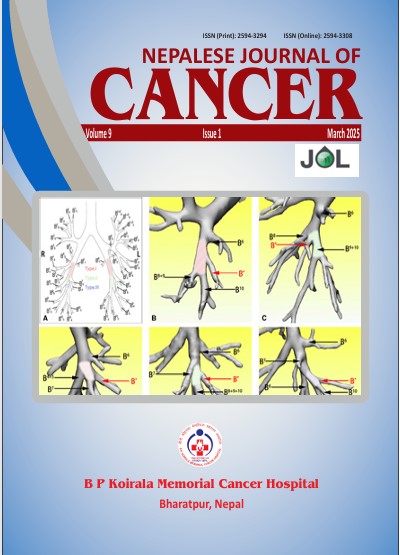Pattern of Breast cancer: A study from western Nepal
DOI:
https://doi.org/10.3126/njc.v9i1.77251Keywords:
Breast Cancer, , western Nepal, treatment, protocolAbstract
Introduction: Breast cancer is the most common cancer among females, accounting for 18.5% of cases globally. It is a heterogeneous disease with varying clinical, pathological, and molecular features. Molecular classification into Luminal A, Luminal B, HER2-enriched, and Triple-Negative subtypes, based on immunohistochemical markers (ER, PR, HER2, Ki-67), guides treatment decisions. Neoadjuvant therapy improves survival, particularly in Triple-Negative Breast Cancer (TNBC), and reduces surgical extent. This study analyzes breast cancer patterns at a tertiary care center to contribute to national data.
Methods: A descriptive cross-sectional study was conducted at Sushil Koirala Prakhar Cancer Hospital from January 2018 to January 2024. Data were collected from medical records and patients, including demographic details, risk factors, histopathology, TNM staging, and chemotherapy protocols. Immunohistochemistry classified molecular subtypes per St. Gallen Consensus 2011 guidelines. Statistical analysis was performed using SPSS version 23.
Results: A total of 166 breast cancer patients were studied, with a mean age of 51.2±12.79 years. Most were married (91%), and only 2.4% had a family history of breast cancer. Delayed treatment (>3 months) was observed in 60.8% of cases. The most common tumor stage was T3 (35.5%), and the most frequent molecular subtype was Luminal A (31.3%). Stage IIIA was predominant (33.1%). Estrogen receptor positivity was found in 57.2% of cases. The most used chemotherapy regimen was AC 2-weekly followed by 2-weekly paclitaxel (29.5%). The majority (63.3%) were referred cases from other institutions.
Conclusion: This study highlights that most breast cancer cases in western Nepal present at advanced stages, with delayed treatment initiation in a significant proportion. Luminal A was the predominant subtype, and chemotherapy with AC 2-weekly followed by paclitaxel was most commonly used
Key words: Breast Cancer, western Nepal, treatment, protocol
Downloads
Downloads
Published
How to Cite
Issue
Section
License
Copyright (c) 2025 Nepalese Journal of Cancer

This work is licensed under a Creative Commons Attribution 4.0 International License.
This license lets others distribute, remix, tweak, and build upon your work, even commercially, as long as NJC and the authors are acknowledged.
Submission of the manuscript means that the authors agree to assign exclusive copyright to NJC. The aim of NJC is to increase the visibility and ease of use of open access scientific and scholarly articles thereby promoting their increased usage and impact.




